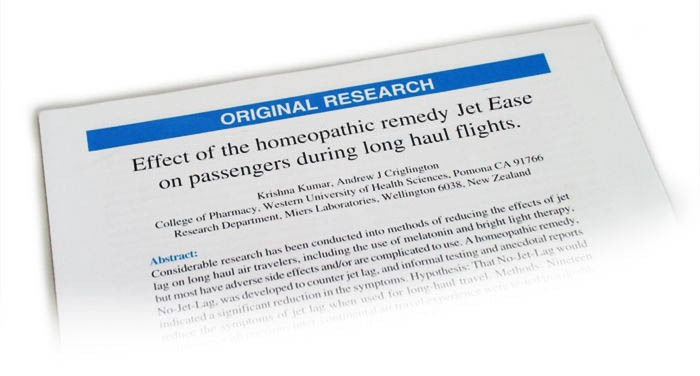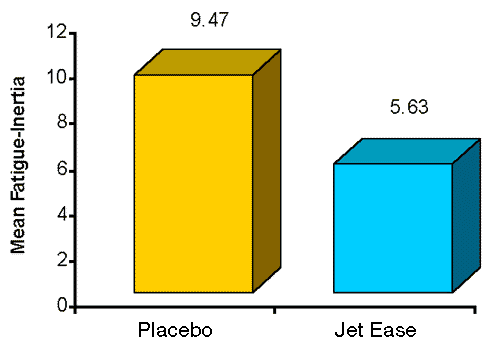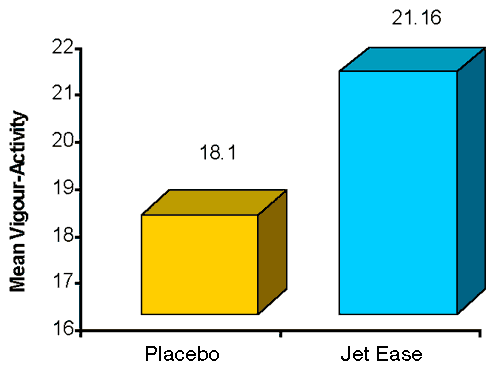
JET EASE SCIENTIFIC TEST
Considerable research has been conducted into methods of reducing the effects of jet lag on long haul
air travelers, including the use of melatonin, special diets and bright light therapy, but most have adverse side effects
and/or are complicated to use. A homeopathic remedy, jet ease, was developed to counter jet lag, and informal testing
and anecdotal reports indicated a significant reduction in the symptoms.
Hypothesis:
That jet ease would reduce the symptoms of jet lag when used for long-haul travel. Methods: Nineteen
volunteers with previous inter-continental air travel experience were tested in a double blind, placebo controlled crossover
trial on a flight from New Zealand to Europe and return (equivalent to travelling round the world), completing survey forms
before departure and after arrival on each leg.
Results:
The subjects taking the remedy showed less fatigue-inertia and had more vigor-activity compared to the subjects
taking the placebo.
Conclusion:
The homeopathic group remedy, jet ease, can reduce jet lag symptoms after long-haul flights.
Introduction
Jet lag symptoms are a common problem for air travelers after long flights especially when passing through several time zones. They are regarded as a significant factor impairing the post-flight performance of business travelers, sports competitors and general users of long-distance air transport. Jet lag is attributed primarily to the body's need to resynchronize its endogenous circadian rhythm to the night and day cycle of the new environment. Other factors however are also believed to exacerbate the symptoms of jet lag. These include the traveler being tired, stressed, ill or hung-over at the start of the journey; the dryness and sometimes the staleness and lack of air in aircraft passenger cabins; alcohol consumption, which can exacerbate dehydration; restricted physical mobility during the flight; and pressure changes associated with the rapid climb to and descent from cruising altitudes of around 30,000 feet, which are not fully compensated even in pressurized aircraft.
Melatonin has been trialed many times and has been found to be successful in alleviating jet lag (3), but long term side affects are a concern and yet to be established. In some countries including the European Community, Canada and Australia, such concerns have led to the status of melatonin being changed from over-the-counter to prescription only sale. In the USA, melatonin remains freely available. The dosage is complicated, with subjects taking melatonin for several days before the flight and again for several days after the flight is completed. Timing of the dose has been found to be crucial, and incorrect use can result in jet lag being made worse rather than better. One group which started using melatonin after returning home from a nine-day tour of duty reported significantly less jet lag and sleep disturbance during the recovery period than a placebo group, but another group starting melatonin before arrival home made a worse recovery than the placebo group, reporting more jet lag and fatigue symptoms (4). Some reports indicate that users who forgot to take melatonin on the third night after returning home found jet lag symptoms returning the following day.
Bright light therapy is another approach to the problem of jet lag, but as with melatonin, the treatment is complicated. Eastward travel requires exposure to bright light early in the day after arrival and westward travel requires exposure to bright light at the end of the day (5). The light intensity required is 3,000 lux which is available outside in warm climates but not in colder climates or for those who are restricted to other activities (6). A solution to the lack of bright outdoor light is the use of light boxes. These range in price from US$40 to US$400 and usually weigh about 10lbs, making treatment by light boxes both expensive and inconvenient.
Another method is the anti jet lag diet. Like Melatonin this is only for people with lots of time on their hands who can devote several days before and after a trip to looking after themselves. It is complicated and there is little evidence that it works, although it has some passionate devotees.
The impracticalities, complexities and expense of the above treatments suggest the need for other approaches to the problem of jet lag. The homeopathic approach was adopted because of the simplicity and effectiveness of the dosage regimen and the lack of toxic side effects.
Methods
The trial was designed to investigate the effects of jet ease during and after a group's flight from Auckland, New Zealand, to Frankfurt, Germany, and return, in such a way that feelings of jet lag and mood could be closely monitored for seven days after each part of the trip.
Subjects completed a Profile of Mood States questionnaire designed to measure six fluctuating affective states, two of which were relevant to jet lag, namely, vigor-activity and fatigue-inertia. They were asked other questions on how anxious and energetic they felt. In addition a self-evaluation questionnaire was used to study issues related to jet lag such as stress, nervousness, confusion, calmness and self confidence. These questionnaires were filled in two hours prior to departure, and again the day after arrival at both Frankfurt and Auckland, and finally seven days after arrival at both destinations. Subjects were also encouraged to make any comments they thought might be useful to the outcome of the trial.
All participants were seasoned travelers with experience of long inter-continental flights through at least five time zones, and were in good health. The group consisted of proficient skiers who had previously traveled from New Zealand to North American and European ski fields, and this was their annual trip to Europe to ski and buy equipment. Having a level of fitness higher than that of average travelers, they were possibly able to resist the effects of jet lag better than most.
The subjects flew from Auckland to Frankfurt in an eastward direction through 12 time zones on a 23-hour flight, returning on a similar flight of 25 hours westwards 16 days later. The subjects were randomly assigned in a double blind procedure to receive jet ease or the placebo on the outward flight and the other substance on the return journey. Each subject received one bottle of tablets in Auckland and the other bottle before departure in Frankfurt for the return journey. Each bottle was labeled with either a "M" or "F" for gender identification and a three digit code. These same codes were placed on each sheet of the questionnaire. The subjects chewed one tablet on takeoff, one tablet every three hours while flying and one tablet after landing.
Jet ease is manufactured according to guidelines of the Homeopathic Pharmacopoeia of the United States of America (HPUS), under GMP conditions.
Statistics
The POMS, a profile of moods states questionnaire designed to measure six fluctuating affective states, was used in the trial. Two of the POMS scales are considered relevant to jet lag, namely vigor-activity and fatigue-inertia (7). Individual scale items were summed using standard procedures, and the data were analyzed with the statistical package for the social sciences, SPSS (8), with one-way analyses of variance and t tests.
Results
The data showed mean fatigue inertia scores (Fig. 1) were consistently higher in subjects taking placebos than in subjects taking the remedy (9.47 vs 5.63; p = 0.026). The mean vigor activity (Fig. 2) was also lower in subjects taking the placebo than in subjects taking the remedy (18.11 vs 21.16; p = 0.072). For all of the other states measured the p value was greater than 0.05.
Jet ease reduces fatigue/tiredness and increases energy/vigor compared with
taking a placebo or not using any treatment when flying long distances.

Fig. 1. Differences in fatigue-inertia scores between the two groups placebo and jet ease (dose every three hours while flying) on a long haul flight from Auckland, New Zealand to Frankfurt in Germany and return. (N=19). P=0.026 which indicates a significant difference between the placebo and jet ease administration.

Fig. 2. Differences in vigor-activity scores between the two groups placebo and jet ease (dose every three hours while flying) on a long haul flight from Auckland, New Zealand to Frankfurt in Germany and return.(N=19) and p = 0.072.
Analysis of the survey forms completed after each leg showed subjects taking jet ease experienced less jet lag and took less time to recover from their shift across 12 time zones.
Those taking jet ease slept without interruption on the first night after arrival and woke up the next morning refreshed and feeling quite normal, whereas those who took the placebo did not sleep well, woke up at strange times in the night and had difficulty getting back to sleep and woke up the next morning feeling jet lagged. The difference was also borne out by their skiing performance after arrival. Those who had taken the remedy reported skiing well, while those who had taken the placebo were still tired and skied poorly the first day and even during later sessions on the slopes. When asked if they knew whether they had taken the remedy or the placebo, they said that at the time of arrival in Germany the whole party all felt very tired but most were already fairly sure which treatment they had taken. By the next day when they had been skiing it was increasingly obvious which treatment they had taken. The consensus view by those taking jet ease was that they were skiing as well as they would have on a local ski field at home, apart from slight tiredness. Those skiers who took the placebo took several days to return to their usual skiing ability.
After the trial was completed, subjects were asked if they thought jet ease was effective in treating jet lag. Of the 19 who completed the trial, 14 (74%) said it was effective, five said they were not sure, and none said it was not effective. Those who were not sure said they thought that jet ease had helped, but were not certain it was completely effective in treating jet lag. Overall those who used jet ease said they skied to their usual level and felt normal, while those taking the placebo said their skiing ability had dropped and they felt jet lagged. On the outward journey, of the 19 taking part 13 (68%) correctly guessed whether they had taken the placebo or jet ease. Of the others, three did not know and three incorrectly assigned themselves to the wrong group.
On the return journey, two were incorrect, three did not know and 14 (74%) correctly guessed. By comparison, a trial of Melatonin (2) involving 17 travelers showed that on the outward leg nine did not know, six guessed incorrectly and five guessed correctly, while on the return leg five did not know, six were incorrect and nine were correct. Subjects in the jet ease trial were asked to comment on any side effects or difficulties in taking either the placebo or the remedy. No difficulties or side effects were reported. This result was as expected, as there are no reported side effects of the ingredients in either the placebo or jet ease.
The tour leader reported that in conversation with subjects at the time of completion of the last questionnaire, several commented that they had noticed when using jet ease that they experienced less swelling of lower limbs, found it easier to sleep in flight and a lack of disrupted sleep in the days after arrival. These effects were not specifically tested for in the trial and warrant further tests.
The results of this study support the use of jet ease as a remedy for jet lag symptoms on long haul flights. These results were consistent with those from informal testing of jet ease carried out since 1988, including a survey of 55 flight attendants on routes between New Zealand and Asia, North America and Europe, which showed 75% considered the remedy effective (1).
The lack of any adverse side effects in subjects taking jet ease suggests it is well tolerated at the dose used. Further trials are suggested to specifically test individual factors that may or may not contribute to jet lag, for example the amount of water and alcohol drunk (as dehydration is suspected of being a factor in jet lag). In such further trials the amount of non alcoholic and alcoholic fluids should be carefully monitored and possibly controlled to remove this factor. It is possible that the results in our trial might have been different had we used subjects with only an average level of fitness rather than the higher level possessed by those doing the trial, although we have no reason to believe this would be so.
Author:
Professor K. Kumar Ph.D.
Professor of Biopharmaceutics/Pharmacokinetics
Howard University, College of Pharmacy
Washington D.C. 20059
United States of America
References:
-
Miers Laboratories, Do flight professionals get jet lag? Aviation, Space, and Environmental Medicine. Page 810, Number 8, Volume 69, August 1998.
-
Recht LD; Lew RA; Schwartz. A letter, Baseball teams beaten by jet lag. Nature, 377 (6550): 583 1995 Oct 19.
-
Petrie K, Conaglen JV, Thompson L, Chamberlain K. Effect of melatonin on jet lag after long haul flights. Br Med J 1989; 298, 705-707.
-
Petrie K, Dawson AG, Thompson L, Brook R. A double-blind trial of melatonin as a treatment for jet lag in international cabin crew. Biol Psychiatry 1993; 33:526-530.
-
Daan S, Lewy AJ. Scheduled exposure to daylight; a potential strategy to reduce jet lag following transmeridian flight. Psychopharmacol Bull 1984; 20:566-568.
-
Wever RA. Light effects on human circadian rhythms: A review of Andechs studies. J. Biol Rhythms 1989;4:161-185.
-
McNair DM, Lorr M, Droppleman LF, Edits manual for the profile of mood states. San Diego: EDITS, 1981.
-
SPSS Incorporated. Users guide to statistical package for the social sciences - X. New York: McGraw-Hill, 1983.
Click below for information on:
Click here for the European Site
taking a placebo or not using any treatment when flying long distances.


Professor of Biopharmaceutics/Pharmacokinetics
Howard University, College of Pharmacy
Washington D.C. 20059
United States of America
Miers Laboratories, Do flight professionals get jet lag? Aviation, Space, and Environmental Medicine. Page 810, Number 8, Volume 69, August 1998.
Recht LD; Lew RA; Schwartz. A letter, Baseball teams beaten by jet lag. Nature, 377 (6550): 583 1995 Oct 19.
Petrie K, Conaglen JV, Thompson L, Chamberlain K. Effect of melatonin on jet lag after long haul flights. Br Med J 1989; 298, 705-707.
Petrie K, Dawson AG, Thompson L, Brook R. A double-blind trial of melatonin as a treatment for jet lag in international cabin crew. Biol Psychiatry 1993; 33:526-530.
Daan S, Lewy AJ. Scheduled exposure to daylight; a potential strategy to reduce jet lag following transmeridian flight. Psychopharmacol Bull 1984; 20:566-568.
Wever RA. Light effects on human circadian rhythms: A review of Andechs studies. J. Biol Rhythms 1989;4:161-185.
McNair DM, Lorr M, Droppleman LF, Edits manual for the profile of mood states. San Diego: EDITS, 1981.
SPSS Incorporated. Users guide to statistical package for the social sciences - X. New York: McGraw-Hill, 1983.
Click below for information on: